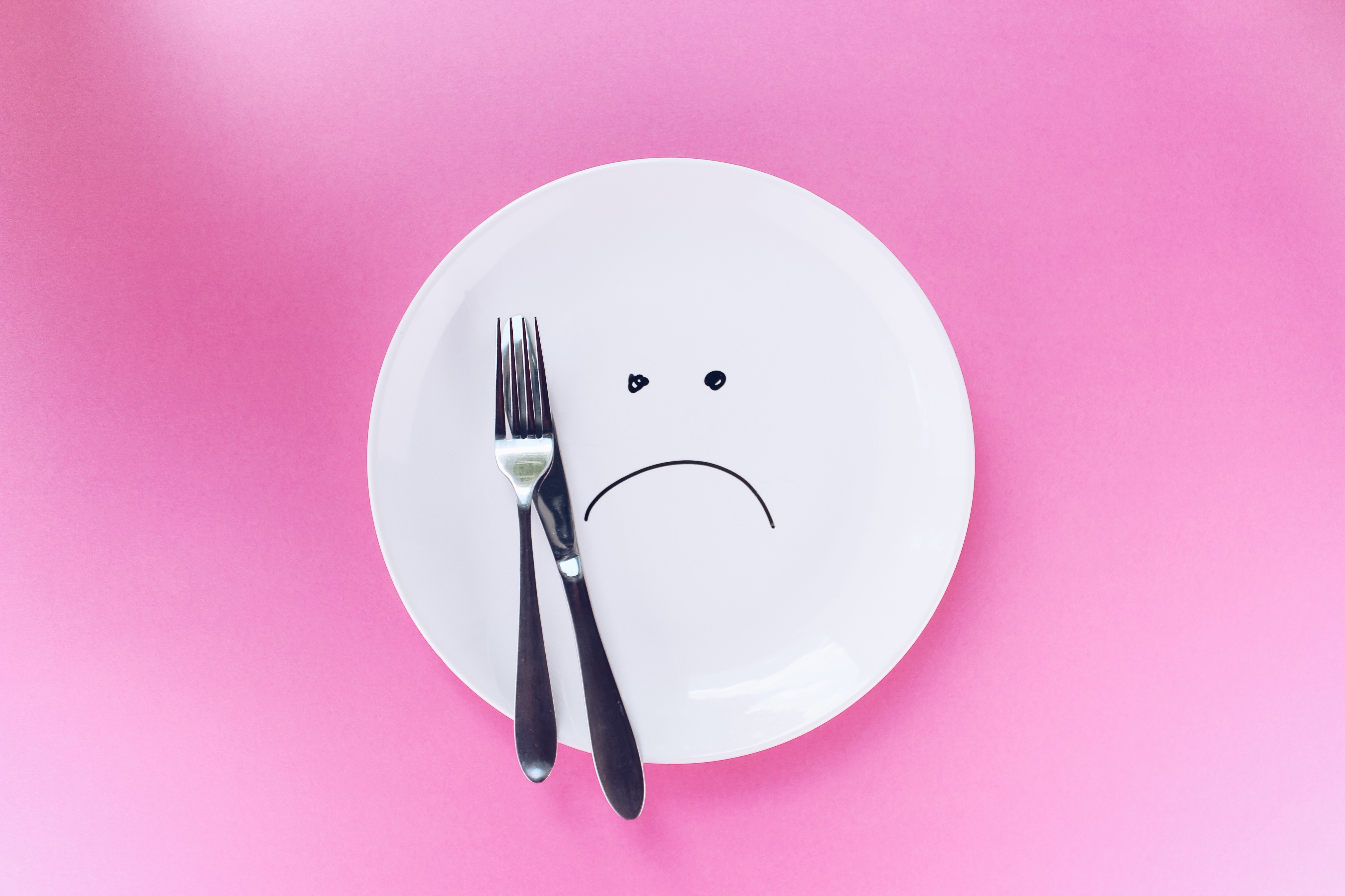Does it really work? My personal story ? and a deep dive into the science.

Thanks to eight weeks of intermittent fasting, hubby and I are fitting easily into the grubby clothes we donned two decades ago when we fell in love in grad school. Here is our firsthand look at the good, bad, and ugly aspects of this hot dietary trend.
For us, it all started with Jimmy Kimmel, a devotee of 5:2 intermittent fasting. When I told my hubby about Kimmel?s weight loss journey, he was immediately drawn to the simplicity and elegance of the 5:2 fasting plan. All you do is dramatically reduce your food intake two days a week. On the other five days, you eat as you please, known as ?ad libitum? eating. When hubby announced the next morning that he was jumping in with both feet, and I quickly followed suit. I figured I had nothing to lose, besides a little cushioning. If it worked, I?d fit my vintage jeans. If it failed, I?d have a good story.
Neither of us science geeks normally turns to celebrities for nutritional advice, but Kimmel?s diet offers more than just stardust. It?s backed not only by successful human trials, but also by a solid mechanism ? calorie deficit. Even if you (somewhat) loosen your belt on the five ad libitum days, you won?t completely erase the large calorie deficit created on your fasting days.
While I realize that counting calories is out of vogue, the science says otherwise: energy balance (calories in vs calories out) is a strong predictor of weight loss. Indeed, the latest scientific review says that intermittent fasting is not superior to old school continuous caloric restriction for weight loss; it?s just a matter of which approach suits you. Some claim that fasting imparts other health benefits, but that?s a topic for another time!
Our Plan
 Photo by Nikiya Christie on Unsplash
Photo by Nikiya Christie on Unsplash
- Two non-consecutive ?fasting? days per week. We allowed ourselves 500 calories per day on our ?fasting? days (~20?25% of our normal calories). Others stick to water and zero calorie beverages. Technically, this is not true fasting; I call it pseudo-fasting. We typically fasted on Mondays and Thursdays but flexed this depending on our social and work commitments.
- Five ?feast? days per week. On these days, we ate as we pleased, which wasn?t very far from our normal eating habits. We did not go overboard downing huge tubs of ice cream and whole pizzas. We both tend to eat mostly healthy foods, but habitually indulge in larger portions than we need, later declaring ?Ugh, I shouldn?t have gone back for seconds, I really didn?t need that?. These frequent seconds and snacks take their toll over the years?
Here is a candid look at our experience. Yours will probably be very different so take this with a grain of salt!
The Good
 Here they are. The real deal from 2006.
Here they are. The real deal from 2006.
It worked!
My circa 2006 bootcut jeans fit like they did back in the day and hubby is back to his favourite belt notch. I was quite surprised because those ?last 5 pounds? tend to be quite stubborn. Like all dietary plans, a good chunk of weight came off quickly in the first few weeks, after which point the scale bumped up and down in a gradual downward direction.
When you run the calorie numbers, this result is not that surprising ? we were consuming 20?25% fewer calories over the course of the week (see Appendix for calculations). The two fasting days essentially served as a credit limit extension on the other five days. While we could have blown our fasting ?credit? by downing a couple of extra tubs of ice cream, neither of us felt compelled to swing the pendulum so far from normal.
It didn?t require constant vigilance.
The tried and true way to lose weight is to tighten your belt a little bit every day and be very mindful of splurges. I?ve had success in the past with this, but find it unforgiving and grueling. Hubby and I both liked the fact that by going hard on two days a week, we could relax on the other five days and enjoy our usual diet of healthy foods, with somewhat liberal portions, and the odd splurge.
It provided a sense of empowerment.
Both hubby and I found pseudo-fasting to be easier than we expected. I was worried that I would get hunger pangs, be unable to focus, and be a generally unbearable grouch, but none those things happened. Yes, we were hungry, but it was very manageable. Amazingly, we weren?t at each others? throats, as you may expect for a hangry couple trying to coax three young kids through the evening rituals. In fact, we were originally going to try the plan for four weeks, but extended it to eight because we felt we were getting big results for minimal effort. I found it liberating to realize that I am not as dependent on constant food as I thought I was.
It fostered more mindful eating.
I vividly remember our first fasting day check-in when my husband fessed up about the apple that magically jumped from the fruit bowl at work into his mouth. In my case, bread crusts and other last morsels tend to fly from my children?s plates into my mouth. It?s also not uncommon for me to be full before the meal even starts when I cook, thanks to a million tiny tastes. The increased mindfulness spilled over to the non-fasting days.
It prompted reflections on our relationships with food.
Hubby and I both quickly realized that we use food in many more ways than just nourishment ? as a reward, as a mood lift, out of boredom, or just because it?s there. I came away feeling that we could both benefit from bolstering our toolkits. Instead of meeting for happy hour with a drink, why not go for a walk? Instead of munching on chocolate after the kids are finally settled in bed, why not read a book or call a friend?
The Bad
 Photo by Thought Catalog on Unsplash
Photo by Thought Catalog on Unsplash
We experienced hunger and other physical side effects.
There is no denying that we were both hungry on our fasting days, and that hunger is not a pleasant feeling. Yet, it was relatively mild hunger, and easy to ignore if we kept busy and chose our foods and drinks strategically. Hubby and I both had somewhat restless sleeps the night after our fasting days. I experienced a few headaches, but they were minor and inconsistent.
We missed out on some of the joys of food.
My husband once commented: ?I feel that a day without food is a joyless day?. My first instinct was to fret and say ? we need to find some other sources of joy! Another part of me knows that finding joy in food is not all bad. Food has always been a cornerstone of human socialization. Since we were only pseudo-fasting, we still managed to pull off family dinners, but the experience just wasn?t the same on belt-cinching days.
The Ugly
 Photo by Kobby Mendez on Unsplash
Photo by Kobby Mendez on Unsplash
This ugly side of this diet is that it does not address the underlying habits that led to the extra pounds you are seeking to shed. This ugliness applies to any short term ?diet?. If we revert back to our old eating habits, the weight will quickly come back.
Thus, while I am excited to share our success story, I want to emphasize the importance of being honest with yourself about your habits and of developing a long term, sustainable plan for healthy eating.
In a perfect world, instead of losing weight by dieting we would all rid ourselves of any habits that brought us to a place where we want to lose weight. I urge you to be brutally honest with yourself about what those habits are. For me, it?s not the treats that tip my energy balance, but the many mindless bites that fly into my mouth throughout the day and the overly generous dinner portions.
I continue to work on these habits. At the same time, I feel good about using tricks like intermittent fasting ? with my eyes wide open. By undereating periodically, I buy myself some flexibility, and still get to wear my favourite old jeans. It?s a trade off that works for me, but is definitely not for everyone.
For now, hubby and I are thinking that a 1:6 version of intermittent fasting may work well for us in the long run, but time will tell whether or not this tradeoff continues to feel good.
Is intermittent fasting safe? Who should NOT try it?
 Photo by Muukii on Unsplash
Photo by Muukii on Unsplash
Intermittent fasting is generally safe for adults without existing medical conditions. Human trials have not reported dangerous adverse events in this population. While scientific reviews have noted that long-term safety data are lacking, I take comfort in the fact that humanity has a long history of safe intermittent fasting, be it for religious or practical reasons.
Anyone with an existing medical condition should check with their physician before proceeding. Some of the common groups for which intermittent fasting is NOT advised include:
- Children and teens
- Women who are pregnant or breastfeeding
- Diabetics and others with metabolic disorders
- Anyone who uses medications that require food intake
- Anyone with a history of disordered eating (e.g. anorexia or bulimia nervosa).
Last but not least, always listen to your body if something feels wrong. It?s better to play it safe and check with a healthcare professional.
Tips for successful intermittent fasting
 Photo by Sam Truong Dan on Unsplash
Photo by Sam Truong Dan on Unsplash
- Enlist support from others. Tell others what you are doing so that they can support you. Better yet, find a partner on your foray into fasting.
- Be mindful of your food environment. Choose to fast on days that you have minimal food-related social or work engagements. Avoid places that are full of temptations, such as cafes filled with the aroma of baked goods!
- Drink smart and drink often. On my pseudo-fasting days, I drink a lot of water, but also veggie broth and sometimes electrolyte drinks. I don?t feel I strictly need the non-water drinks, but they help keep me satisfied. I also tend to opt for tea over coffee, as it sits better in an empty stomach.
- Choose fiber-rich foods. Fiber-rich foods help you feel more satiated, and keep you regular. Our mini-meals included lots of veggies and moderate amounts of protein-rich foods like hummus.
- Stay busy. Distractions (like work, or outings) help shift your focus away from hunger.
- Dial down your physical activity. I tend not to do intense workouts on fasting days (mostly because they make me hungry!) but keep active with lots of walking.
- Know what to expect. A little hunger is okay, and safe. Headaches are also fairly normal, and are only a concern if they persist.
- Listen to your body. Don?t push it if it feels unsafe ? like if you feel you may pass out. Such reactions are uncommon, especially with pseudo-fasting, but can crop up due to underlying medical issues. Play it safe.
Closing Thoughts
 Photo by Chander R on Unsplash
Photo by Chander R on Unsplash
Intermittent fasting is a viable strategy for losing weight, but there is no magic to it. It works by creating a calorie deficit through periods of fasting that you ? hopefully ? don?t undo on your non-fast days. It will only be successful if you eat relatively normally on non-fasting days (you can splurge, but within reason).
This may sound like an extreme approach to weight management, but when you consider how humans have historically eaten, and the more extreme fasting we can handle, this diet looks rather tame. When obesity has reached epidemic proportions, eating ?normally? is not necessarily a good thing.
Long term weight maintenance is a much harder problem; one without a one-sized-fits all solution. The holy grail is to overcome the triggers behind the eating habits that don?t serve us well. For many of us, this is easier said than done, which is why I?m comfortable incorporating little tricks like intermittent fasting ? along with brutal honesty about the roots of my self-sabotage.
Think of healthy eating as a marathon, not a sprint. The odd ?kick? can be useful but we must pace ? and fuel ? ourselves for the long haul.
As you develop your long term strategy, consider these factors: Is it a physiological fit? How does your body feel? Does it fit your lifestyle? Is it a mental fit? Does it help or hinder your relationship with food? Last but not least, does it preserve the joyful role that food can play, both the taste and the social aspects of food?
If you decide to take the plunge, I hope you will be as pleasantly surprised as we were with its effectiveness, and enjoy the bonus benefits, like a boost in mindful eating. First, please see my contraindications above and contact your doctor if you are unsure.
Get ready to bust out those vintage jeans!
Stay tuned to see how we fare as we move to the truly challenging part ? long-term maintenance.
Future topics
- How does intermittent fasting compare to weight loss from daily caloric restriction? Is it more, less, or equally effective for weight loss? Do you lose fat or non-fat differentially depending on your strategy? Do they differentially impact your body?s compensatory mechanisms (like slower metabolic rate)?
- Does intermittent fasting (or other types of fasting) impart benefits beyond weight loss, such as better insulin regulation, cardiovascular health, or longevity? Which benefits can be explained by weight loss?
- How does time-restricted fasting compare to intermittent fasting on all these fronts?
Appendix
- A balanced look at pros, cons and unknowns about intermittent fasting (Harvard Health).
- Effectiveness of intermittent fasting for weight loss (2018 JBI meta-analysis of human trials)
- Safety questions: adverse events associated with extreme (water) fasting (2018 review study)
Calorie calculations for adult male (baseline = 2,400 caloriesper day)
- Pseudo-Fast days: 500 calories (N=2) = 1,000 calories per week
- Feast days: 2,400 calories (N=5) =12,000 calories per week
- Total weekly calories = 13,000
- % calorie intake = 13,000 / 16,800 = 77%
- Calorie deficit = 23%*
Calorie calculations for adult female (baseline = 1,800 calories per day)
- Pseudo-Fast days: 500 calories (N=2) = 1,000 calories per week
- Feast days: 1,800 calories (N=5) = 9,000 calories per week
- Total weekly calories = 10,000
- % calorie intake = 10,000 / 12,600 =79%
- Calorie deficit = 21% calorie deficit*
*Actual calorie deficit was lower due to a conscious decrease in physical activity on fasting days. Unconscious decreases in energy expenditure may have also dialed things down further.
About Me

I am formally trained in human genetics (PhD) and spent the first decade of my career working in cancer research, drug development, and personalized medicine.
This new career chapter is dedicated to empowering others to make informed choices that taste and feel good, rooted in facts not fears.
See more of my work (and healthy recipes) at https://FueledbyScience.com
Originally published at https://fueledbyscience.com on October 1, 2019.


